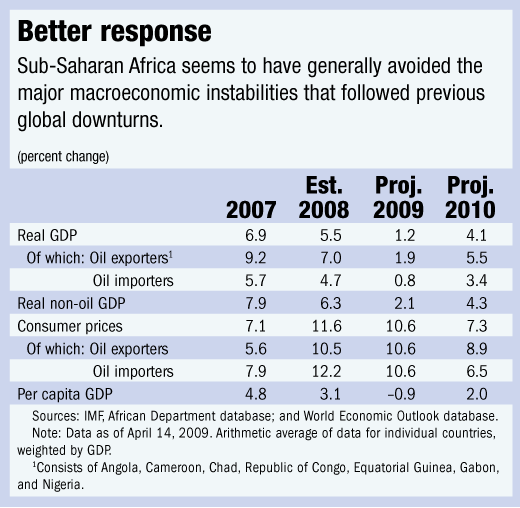
Typical street scene in Santa Ana, El Salvador. (Photo: iStock)
IMF Survey: Prudent Policies Help Sub-Saharan Africa Ride Downturn
October 3, 2009
- Global recession hit Africa hard, but there are signs of resilience
- Prudent policies have given many countries space to counter slowdown
- Solid case for 2010 budgets to aim at fostering economic recovery
As the global economic cycle moves to recovery, there are grounds for optimism that sub-Saharan Africa’s performance relative to the rest of the world will be better than in the past, the IMF says.

Most SSA economies seem to be responding to current global economic crisis better than in past, IMF report states (photo: Newscom)
REGIONAL ECONOMIC OUTLOOK
But the world slowdown is exacting a heavy toll that is all the more harmful given endemic poverty.
In its Regional Economic Outlook for the subcontinent, the IMF says that sub-Saharan Africa (SSA) is set for a recovery to mirror that projected for the rest of the world. The report adds that while average per capita incomes should escape the sustained reductions that marked previous downturns, living standards for some may deteriorate markedly and there may be some acute increases in poverty.
Policies in most SSA economies seem to be responding more positively to the current global economic crisis better than they have in the past, the report states. Fiscal and monetary policies have helped counter the effects of the slowdown and the region seems to have generally avoided the major macroeconomic instabilities that followed previous global downturns.
“The effective use of counter-cyclical macroeconomic tools marks a new era in the policy environment of sub-Saharan Africa,” Antoinette Sayeh, Director of the IMF’s African Department, said in a press briefing.
Growth pickup forecast
Output in sub-Saharan Africa is expected to expand by just 1 percent in 2009 compared with an estimated 5½ percent in 2008 (see table). If government policies remain supportive, and global economic growth recovers as currently expected, growth in SSA should pick up to just over 4 percent in 2010. But there are significant downside risks.

Room for maneuver
Relatively prudent macroeconomic policies during the recent upswing seem to have given SSA countries some room for maneuver in the downturn. On the fiscal side, for example, many countries have been able to let automatic stabilizers operate, and have in some cases even been able to pursue active countercyclical policies.
For the region as a whole, the fiscal balance (including grants) has swung from a surplus of just over 1¼ percent of GDP in 2008 to an expected deficit of 4¾ percent in 2009. This contrasts with the much more limited increase in deficits observed in past global slowdowns, not only because the output shocks were smaller but also most likely because in previous downturns high initial deficits, often accompanied by high debt, limited room for maneuver.
IMF help for Africa
In her briefing, Sayeh highlighted the help the IMF has given to Africa during the crisis. “We have “gone in big” in sub-Saharan Africa this year,” she stated. “Already, 15 countries have received new programs, or have had existing ones augmented. Over $3 billion has been committed – and in quicker, more flexible, and larger amounts than in the past, with fewer conditions. More to the point, there are further improvements to come,” she added. Sayeh said the revamping of the architecture of Fund facilities this year means the IMF now has three finely-tuned mechanisms for providing highly concessionary assistance to low income countries, plus the non-financial Policy Support Instrument. “It is more clear than ever throughout the continent that the Fund is a true and valued partner–not only for finance but also for advice and sustained technical support, including through our regional technical assistance centers,” she added.
On the external side, too, in marked contrast to previous slowdowns, the region’s current account balance in 2008 was relatively strong and international reserves fairly high. This enabled most countries to cope with the sharp declines in foreign exchange inflows without provoking a reserves crisis.
Policy priorities
Stressing that a quick recovery in SSA presumes that the slowdown has already hit bottom, the report cautions that evidence of a trough is patchy at best. The report sets out several policy priorities to be addressed against such a backdrop.
• Countries have to varying degrees allowed automatic stabilizers to operate on the revenue side and in some cases increased discretionary spending. Such fiscal stimulus should not be withdrawn too early. There is a solid case for formulating budgets into 2010 with an eye to fostering economic recovery.
• As evidence emerges that economic recovery is gaining traction, the emphasis of fiscal policy will need to shift much more toward medium-term considerations—and in particular growth and debt sustainability issues.
• In countries where financing constraints are more binding, policies should remain geared to containing macroeconomic imbalances to avoid further undermining economic growth.
• The case for monetary policy to remain supportive in the coming months is even stronger. Inflation in most countries has reverted to single digits, the amount of monetary policy easing to date has been relatively modest, and the likelihood of a significant liquidity overhang is accordingly minimal.
• Countries need to continue monitoring financial sector developments closely. As the experience of countries with apparently more capable regulatory agencies has shown, financial sector problems can have severe consequences for the real economy.
Comments on this article should be sent to imfsurvey@imf.org


